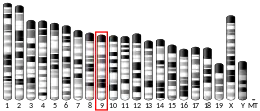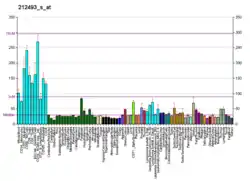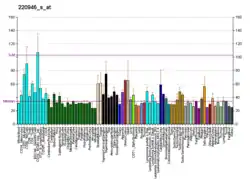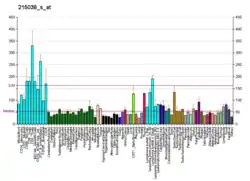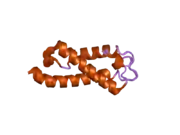SETD2
SET domain containing 2 is an enzyme that in humans is encoded by the SETD2 gene.[5][6][7]
Function
SETD2 protein is a histone methyltransferase that is specific for lysine-36 of histone H3, and methylation of this residue is associated with active chromatin. This protein also contains a novel transcriptional activation domain and has been found associated with hyperphosphorylated RNA polymerase II.[7]
The trimethylation of lysine-36 of histone H3 (H3K36me3) is required in human cells for homologous recombinational repair and genome stability.[8] Depletion of SETD2 increases the frequency of deletion mutations that arise by the alternative DNA repair process of microhomology-mediated end joining.
Clinical significance
The SETD2 gene is located on the short arm of chromosome 3 and has been shown to play a tumour suppressor role in human cancer.[9]
Interactions
SETD2 has been shown to interact with Huntingtin.[10] Huntington's disease (HD), a neurodegenerative disorder characterized by loss of striatal neurons, is caused by an expansion of a polyglutamine tract in the HD protein huntingtin. SETD2 belongs to a class of huntingtin interacting proteins characterized by WW motifs.[7]
References
- GRCh38: Ensembl release 89: ENSG00000181555 - Ensembl, May 2017
- GRCm38: Ensembl release 89: ENSMUSG00000044791 - Ensembl, May 2017
- "Human PubMed Reference:". National Center for Biotechnology Information, U.S. National Library of Medicine.
- "Mouse PubMed Reference:". National Center for Biotechnology Information, U.S. National Library of Medicine.
- Sun XJ, Wei J, Wu XY, Hu M, Wang L, Wang HH, Zhang QH, Chen SJ, Huang QH, Chen Z (Oct 2005). "Identification and characterization of a novel human histone H3 lysine 36-specific methyltransferase". J Biol Chem. 280 (42): 35261–71. doi:10.1074/jbc.M504012200. PMID 16118227.
- Rega S, Stiewe T, Chang DI, Pollmeier B, Esche H, Bardenheuer W, Marquitan G, Putzer BM (Jul 2001). "Identification of the full-length huntingtin- interacting protein p231HBP/HYPB as a DNA-binding factor". Mol Cell Neurosci. 18 (1): 68–79. doi:10.1006/mcne.2001.1004. PMID 11461154. S2CID 31658986.
- "Entrez Gene: SETD2 SET domain containing 2".
- Pfister SX, Ahrabi S, Zalmas LP, Sarkar S, Aymard F, Bachrati CZ, Helleday T, Legube G, La Thangue NB, Porter AC, Humphrey TC (June 2014). "SETD2-dependent histone H3K36 trimethylation is required for homologous recombination repair and genome stability". Cell Rep. 7 (6): 2006–18. doi:10.1016/j.celrep.2014.05.026. PMC 4074340. PMID 24931610.
- Al Sarakbi W, Sasi W, Jiang WG, Roberts T, Newbold RF, Mokbel K (2009). "The mRNA expression of SETD2 in human breast cancer: correlation with clinico-pathological parameters". BMC Cancer. 9: 290. doi:10.1186/1471-2407-9-290. PMC 3087337. PMID 19698110.
- Faber PW, Barnes GT, Srinidhi J, Chen J, Gusella JF, MacDonald ME (September 1998). "Huntingtin interacts with a family of WW domain proteins". Hum. Mol. Genet. 7 (9): 1463–74. doi:10.1093/hmg/7.9.1463. PMID 9700202.
Further reading
- Faber PW, Barnes GT, Srinidhi J, et al. (1998). "Huntingtin interacts with a family of WW domain proteins". Hum. Mol. Genet. 7 (9): 1463–74. doi:10.1093/hmg/7.9.1463. PMID 9700202.
- Passani LA, Bedford MT, Faber PW, et al. (2000). "Huntingtin's WW domain partners in Huntington's disease post-mortem brain fulfill genetic criteria for direct involvement in Huntington's disease pathogenesis". Hum. Mol. Genet. 9 (14): 2175–82. doi:10.1093/hmg/9.14.2175. PMID 10958656.
- Zhang QH, Ye M, Wu XY, et al. (2001). "Cloning and functional analysis of cDNAs with open reading frames for 300 previously undefined genes expressed in CD34+ hematopoietic stem/progenitor cells". Genome Res. 10 (10): 1546–60. doi:10.1101/gr.140200. PMC 310934. PMID 11042152.
- Nagase T, Kikuno R, Hattori A, et al. (2001). "Prediction of the coding sequences of unidentified human genes. XIX. The complete sequences of 100 new cDNA clones from brain which code for large proteins in vitro". DNA Res. 7 (6): 347–55. doi:10.1093/dnares/7.6.347. PMID 11214970.
- Strausberg RL, Feingold EA, Grouse LH, et al. (2003). "Generation and initial analysis of more than 15,000 full-length human and mouse cDNA sequences". Proc. Natl. Acad. Sci. U.S.A. 99 (26): 16899–903. Bibcode:2002PNAS...9916899M. doi:10.1073/pnas.242603899. PMC 139241. PMID 12477932.
- Ota T, Suzuki Y, Nishikawa T, et al. (2004). "Complete sequencing and characterization of 21,243 full-length human cDNAs". Nat. Genet. 36 (1): 40–5. doi:10.1038/ng1285. PMID 14702039.
- Beausoleil SA, Jedrychowski M, Schwartz D, et al. (2004). "Large-scale characterization of HeLa cell nuclear phosphoproteins". Proc. Natl. Acad. Sci. U.S.A. 101 (33): 12130–5. Bibcode:2004PNAS..10112130B. doi:10.1073/pnas.0404720101. PMC 514446. PMID 15302935.
- Gerhard DS, Wagner L, Feingold EA, et al. (2004). "The status, quality, and expansion of the NIH full-length cDNA project: the Mammalian Gene Collection (MGC)". Genome Res. 14 (10B): 2121–7. doi:10.1101/gr.2596504. PMC 528928. PMID 15489334.
- Li M, Phatnani HP, Guan Z, et al. (2006). "Solution structure of the Set2-Rpb1 interacting domain of human Set2 and its interaction with the hyperphosphorylated C-terminal domain of Rpb1". Proc. Natl. Acad. Sci. U.S.A. 102 (49): 17636–41. doi:10.1073/pnas.0506350102. PMC 1308900. PMID 16314571.
- Lim J, Hao T, Shaw C, et al. (2006). "A protein-protein interaction network for human inherited ataxias and disorders of Purkinje cell degeneration". Cell. 125 (4): 801–14. doi:10.1016/j.cell.2006.03.032. PMID 16713569. S2CID 13709685.
- Olsen JV, Blagoev B, Gnad F, et al. (2006). "Global, in vivo, and site-specific phosphorylation dynamics in signaling networks". Cell. 127 (3): 635–48. doi:10.1016/j.cell.2006.09.026. PMID 17081983. S2CID 7827573.



